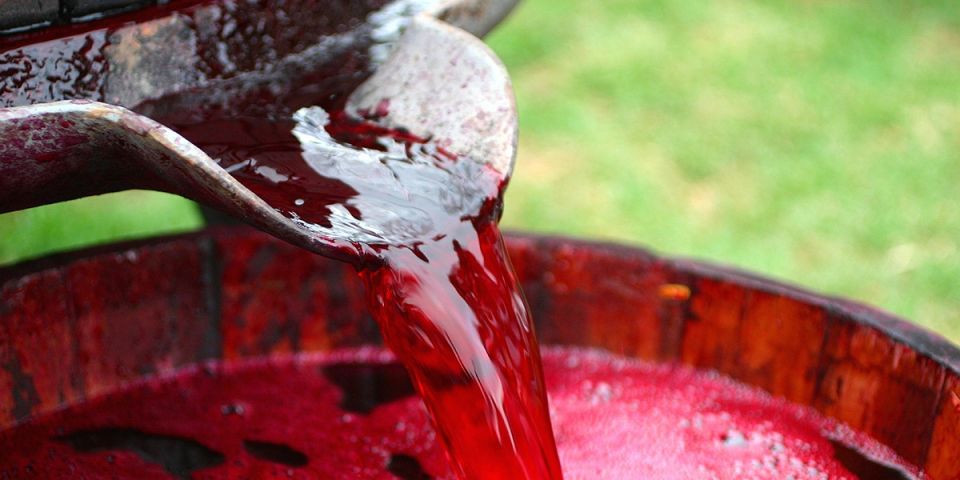If you don't want to de-stem and crush fresh grapes to make wine, then try using fresh wine juice. I stress the word FRESH. It's important that you start with fresh, high-quality pressed juices.
Making Wine from Fresh Juice
Instructions:
1. Remove the lid from your bucket of juice and stir vigorously for a 3 minutes. You may use your pail as the primary fermentation vessel.
2. Dissolve ¼ teaspoon of potassium metabisulfite into ¼ cup of warm water. Add this to your juice. Allow the juice to stand until it reaches a temperature between 60 to 70 degrees.
3. Using a hydrometer take a specific gravity or brix reading. Record this reading.
Your fresh juice has been balanced to 21 to 23 brix at time of production. If your brix reading is lower than expected, it's possible that fermentation has begun. Do not add sugar to your juice unless you are trying to raise the finished alcohol level.
4. Remove about a half gallon of the juice from the pail using a small sauce pan. This will prevent the bucket from overflowing during your primary fermentation. Place the excess juice in a clean vessel. You will reintroduce this juice later back into your bucket if you are using it as the primary fermentation vessel.
5. Pitch your yeast, following the instructions on the packet carefully. We strongly suggest using a good yeast rehydration nutrient in this process. We use and recommend Go Ferm.
6. After you have rehydrated your yeast as instructed on the packet, add an equal volume of juice from the pail to the yeast slurry. Allow 20 minutes, and again add an equal amount of juice from your pail to the slurry. Wait 20 minutes then add the slurry to the remaining juice in the pail. Cover your pail with the lid loosely.
7. Check the specific gravity or brix reading at least twice a day, and record it. After recording your specific gravity or brix, stir juice vigorously for 2 minutes. This is an important step because will remove gas from your juice while it is protected from air by the carbon dioxide being produced during fermentation. After 36 hours you may add the remainder of your juice that was set aside in step 4 back to your primary fermentor bucket. Do this slowly.
8. When your hydrometer shows a reading of 2 brix or specific gravity of 1.01, you will notice that the bubbling or fizzing has slowed down. Be certain to stir very well at this point prior to racking the juice into your carboy or long term storage vessel. Be certain that your pump or siphon and all tubing have been thoroughly cleaned and sanitized, then siphon the juice into the vessel and fill from the bottom. Avoid splashing the juice into the vessel. Fill your carboy or vessel to within one half inch of your cap or bung.
9. Place an air lock with a rubber bung into the top of your carboy. Fill the air lock to the line on the side with peroxide, vodka or grain spirits.. You may also use water treated with a small amount of potassium metabisulfite.
10. Some juice will remain in your pail. You may use a gallon jug or several wine
bottles to store this juice. Do not place a lid or solid cap on these bottles as the primary fermentation is not complete yet. A bung and airlock will work nicely. Most wine bottles will accept a number three drilled bung with an airlock, or you can use a balloon. Most gallon jugs accept a number five and a half or number six drilled bung with an airlock.. You will need this juice when you "rack" a second time to fill the carboy. It is normal for some sediment to remain in the bucket, this is normal. You can dump this remainder.
11. After three weeks, take a specific gravity or brix reading and record it. By now, your primary fermentation should be completed. Your brix reading will be at less than zero or your specific gravity reading would be .990. At this time you will again siphon (rack) the juice from the carboy. Do not disturb the sediment at the bottom of the vessel as removing it is the purpose of racking. You may rack your wine back into the original bucket, clean your carboy and then refill it. Another option is to buy a second carboy to transfer the juice into it. A ¼ teaspoon of potassium metabisulfite should be added at this time. Then place the air lock back into the top. Continue to store the juice at room temperature.
12. In 5 to 6 more weeks remove your air lock and add ¼ teaspoon of potassium metabisulfite dissolved, directly to your wine. If you notice more than 1/8 inch of sediment in the bottom of your carboy at this time, you may want to consider a third racking. The more you rack, the clearer your wine will be.
Important Notes:
Always clean everything that comes into contact with your juice and wine. A gallon bottle with spray attachment is a must have. Fill the bottle with a ¼ teaspoon of potassium metabissulfite and water. This is an excellent way to sanitize after washing any utensil.
Potassium metabisulfite is our friend. Be careful in your measurements. Too much of a good thing is no good.
Buy good corks for your bottles.
Clean everything.
Clean everything again.






